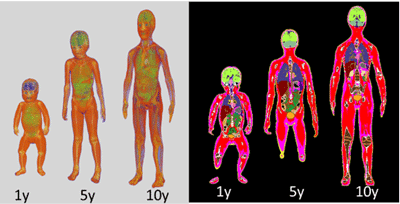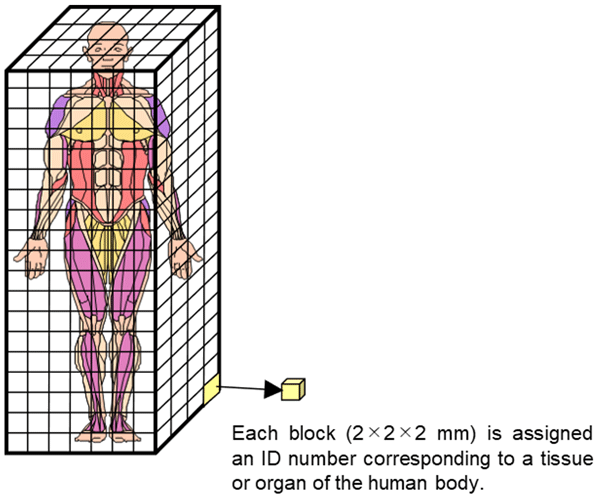Abstract
The National Institute of Information and Communications Technology (NICT, President: TOKUDA Hideyuki, Ph.D.) has developed computational human body models for children aged 1, 5, and 10 years whose body shape and anatomical structure match international references. These models are available free of charge for non-commercial use and are useful for diverse simulations, such as studying electromagnetic field dosimetry and human body injuries in car accidents and enhancing diagnostic and therapeutic practices. They are expected to aid in child safety assessments and advancements in various fields.
Achievements

Figure 1 International reference computational models for children (the left figure is a volume rendering display and the right figure is a cross-sectional view).
NICT has developed international reference computational human models of children to enable highly generalizable EMF dosimetry unaffected by individual differences. These child models are now available free of charge for non-commercial research purposes. Their terms and conditions of use can be found on the following page:
The released models represent 1-, 5-, and 10-year-old children using fine blocks (2 mm cubes) to represent their anatomical structures (see Figure 1). Each block corresponds to about 50 different tissues or organs, adjusted to match the International Commission on Radiological Protection (ICRP)'s reference values for body shape and tissue and organ masses in children. With specific electrical constants assigned to the tissues and organs in each model, the absorption of radio waves in children can be calculated.
These models offer versatility by allowing the substitution of physical properties and enabling numerical simulations and technology development in various fields. To date, adult male and female models have been useful in areas such as human body damage analysis in vehicle collisions and radiotherapy dose optimization. Similarly, these child models have potential applications in various fields.
Future prospects
The data are provided for non-commercial use, but we are considering making the data available for commercial use for a fee in the future. If you are interested, please contact us for more information.
Part of this work was supported by the Ministry of Internal Affairs and Communications under Grant Number JPMI10001.

 ml.nict.go.jp
ml.nict.go.jp